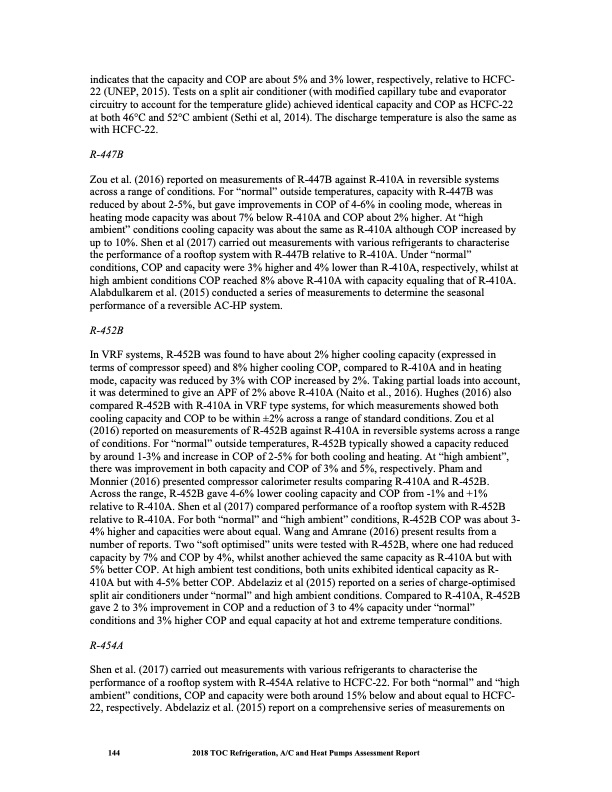
PDF Publication Title:
Text from PDF Page: 157
indicates that the capacity and COP are about 5% and 3% lower, respectively, relative to HCFC- 22 (UNEP, 2015). Tests on a split air conditioner (with modified capillary tube and evaporator circuitry to account for the temperature glide) achieved identical capacity and COP as HCFC-22 at both 46°C and 52°C ambient (Sethi et al, 2014). The discharge temperature is also the same as with HCFC-22. R-447B Zou et al. (2016) reported on measurements of R-447B against R-410A in reversible systems across a range of conditions. For “normal” outside temperatures, capacity with R-447B was reduced by about 2-5%, but gave improvements in COP of 4-6% in cooling mode, whereas in heating mode capacity was about 7% below R-410A and COP about 2% higher. At “high ambient” conditions cooling capacity was about the same as R-410A although COP increased by up to 10%. Shen et al (2017) carried out measurements with various refrigerants to characterise the performance of a rooftop system with R-447B relative to R-410A. Under “normal” conditions, COP and capacity were 3% higher and 4% lower than R-410A, respectively, whilst at high ambient conditions COP reached 8% above R-410A with capacity equaling that of R-410A. Alabdulkarem et al. (2015) conducted a series of measurements to determine the seasonal performance of a reversible AC-HP system. R-452B In VRF systems, R-452B was found to have about 2% higher cooling capacity (expressed in terms of compressor speed) and 8% higher cooling COP, compared to R-410A and in heating mode, capacity was reduced by 3% with COP increased by 2%. Taking partial loads into account, it was determined to give an APF of 2% above R-410A (Naito et al., 2016). Hughes (2016) also compared R-452B with R-410A in VRF type systems, for which measurements showed both cooling capacity and COP to be within ±2% across a range of standard conditions. Zou et al (2016) reported on measurements of R-452B against R-410A in reversible systems across a range of conditions. For “normal” outside temperatures, R-452B typically showed a capacity reduced by around 1-3% and increase in COP of 2-5% for both cooling and heating. At “high ambient”, there was improvement in both capacity and COP of 3% and 5%, respectively. Pham and Monnier (2016) presented compressor calorimeter results comparing R-410A and R-452B. Across the range, R-452B gave 4-6% lower cooling capacity and COP from -1% and +1% relative to R-410A. Shen et al (2017) compared performance of a rooftop system with R-452B relative to R-410A. For both “normal” and “high ambient” conditions, R-452B COP was about 3- 4% higher and capacities were about equal. Wang and Amrane (2016) present results from a number of reports. Two “soft optimised” units were tested with R-452B, where one had reduced capacity by 7% and COP by 4%, whilst another achieved the same capacity as R-410A but with 5% better COP. At high ambient test conditions, both units exhibited identical capacity as R- 410A but with 4-5% better COP. Abdelaziz et al (2015) reported on a series of charge-optimised split air conditioners under “normal” and high ambient conditions. Compared to R-410A, R-452B gave 2 to 3% improvement in COP and a reduction of 3 to 4% capacity under “normal” conditions and 3% higher COP and equal capacity at hot and extreme temperature conditions. R-454A Shen et al. (2017) carried out measurements with various refrigerants to characterise the performance of a rooftop system with R-454A relative to HCFC-22. For both “normal” and “high ambient” conditions, COP and capacity were both around 15% below and about equal to HCFC- 22, respectively. Abdelaziz et al. (2015) report on a comprehensive series of measurements on 144 2018 TOC Refrigeration, A/C and Heat Pumps Assessment ReportPDF Image | Heat Pumps Technical Options

PDF Search Title:
Heat Pumps Technical OptionsOriginal File Name Searched:
RTOC-assessment-report-2018_0.pdfDIY PDF Search: Google It | Yahoo | Bing
CO2 Organic Rankine Cycle Experimenter Platform The supercritical CO2 phase change system is both a heat pump and organic rankine cycle which can be used for those purposes and as a supercritical extractor for advanced subcritical and supercritical extraction technology. Uses include producing nanoparticles, precious metal CO2 extraction, lithium battery recycling, and other applications... More Info
Heat Pumps CO2 ORC Heat Pump System Platform More Info
| CONTACT TEL: 608-238-6001 Email: greg@infinityturbine.com | RSS | AMP |